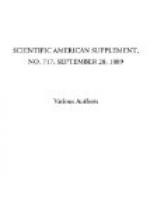In Lancashire and in other inland districts land must be found on which to deposit it, and the act of depositing is costly, for unless it is beaten together so as to exclude the air, an intolerable nuisance arises from it. The cost of haulage and deposit on land varies, according to the district, from 1s. to 1s. 6d. a ton. In Widnes it is about 1s.
In the Newcastle district the practice is to carry this material out to sea at a cost of about 4d. a ton.
Mr. Chance’s process for the recovery of sulphur from the waste signalizes the centenary of the Leblanc process; Parnell and Simpson are following in his wake, and lately Mr. F. Gossage, of Widnes, has been working on a process for the production of alkali, which enables him to save the sulphur of the sulphuric acid. In his process a mixture of 70 parts Leblanc salt cake (sulphate of soda) and 30 parts common salt is mixed with coal and heated in a furnace, and so reduced to sulphide of sodium. The resulting “ash” is then dissolved in water and exposed to the action of carbonic acid, when sulphureted hydrogen is given off, to be dealt with as in Mr. Chance’s sulphur process, while bicarbonate of soda is formed and separates by precipitation from the solution of undecomposed common salt.
Ere long it is expected this new method will be in active operation in some Leblanc works, the plant of which will, in all probability, be utilized. It has these great advantages: The absence of lime, the recovery of the sulphur used in the first instance and the consequent absence of the objectionable tank waste. Thus a bright promise is held out that the days of alkali waste are numbered, and that the air in certain parts of Lancashire will be more balmy than it has been in the memory of the oldest inhabitant.—Chemist and Druggist.
* * * * *
THE FUELS OF THE FUTURE.
It is undeniable that in this country, at least, we are accustomed to regard coal as the chief, and, indeed, the only substance which falls to be considered under the name of fuel. In other countries, however, the case is different. Various materials, ranging from wood to oil, come within the category of material for the production of heat. The question of fuel, it may be remarked, has a social, an antiquarian, and a chemical interest. In the first place, the inquiry whether or not our supplies of coal will hold out for say the next hundred thousand years, or for a much more limited period only, has been very often discussed by sociologists and by geological authorities.




